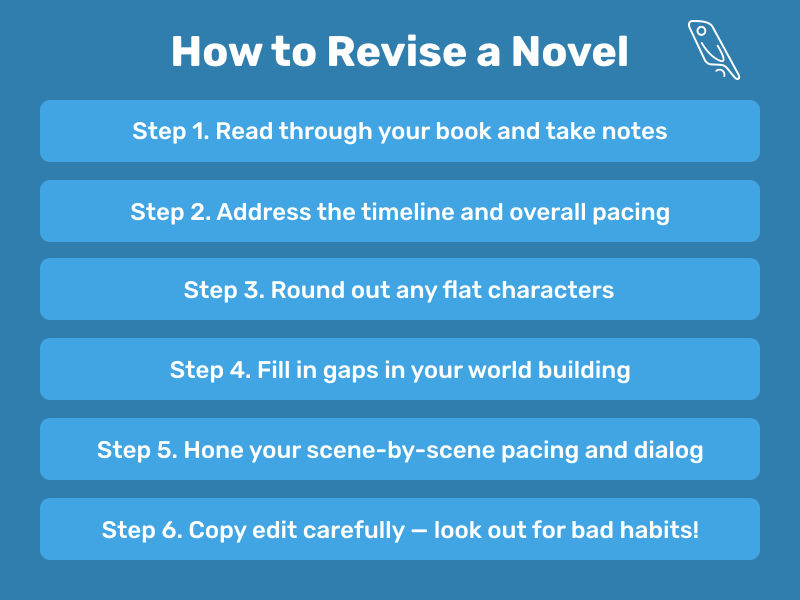Last updated on Oct 15, 2025
How to Revise a Novel: 6 Steps to a Smooth Revision
Martin Cavannagh
Head of Content at Reedsy, Martin has spent over eight years helping writers turn their ambitions into reality. As a voice in the indie publishing space, he has written for a number of outlets and spoken at conferences, including the 2024 Writers Summit at the London Book Fair.
View profile →Whether you’ve spent the past few years meticulously crafting your first draft or just wrote a novel in a month, there’s one thing all authors must do: revise. Knowing how to revise a novel is all about taking those typo-ridden bursts of inspiration and half-finished plot threads and weaving them into something whole. It’s where your raw and messy manuscript finally starts to look like a real book — though it will still take a few more rounds of cleanup and professional editing before it’s ready for its big debut.
It’s also a stage many writers dread. But while revising a book is certainly a big undertaking, you can go in with confidence, knowing that you’ve already done the hardest thing: finishing a draft in the first place!
Before you get started, we recommend downloading the below book editing checklist to make sure you've ticked off all of the boxes.

FREE RESOURCE
Get our Book Editing Checklist
Resolve every error, from plot holes to misplaced punctuation.
And now roll up your sleeves, pick up that red pen, and find out exactly how to take your novel from scruffy to spiffy in six simple steps.
Step 1: Read through your book and take notes
The first thing you’ll need to do is make yourself a game plan.
For this task, you’ll want to read through your novel with as clear a head as possible. You can do one read-through just after you’ve finished if you want, to note the obvious issues, but then you’ll need to put your book aside for a while before you really delve into it.
Getting space from your manuscript is key to putting yourself in a “reader” mindset — and that’s what you’re going to need to assess your work effectively. After all, a reader won’t know your big plot twist as they’re reading the foreshadowing in chapter one; in order to see if it makes sense, you’ll have to try to forget it as well!
As you read, pay attention to:
- When and how you introduce each of your characters. Are they immediately interesting, unique, and memorable? Have you given them distinct features and characteristics?
- How you reveal each plot point. Did you include all the information readers need in order to understand why this event happens?
- The way you present worldbuilding information. Make sure your worldbuilding comes up when it’s relevant, so that it feels organic and readers will remember it. Watch out for info-dumps!
- Does the plot make sense? Is there a causal relationship between events? (Hint: if they can be reordered without impacting the overall story, there probably isn’t!)
- Are there any annoying quirks in your writing? Did you overuse the same phrase, character motion (such as shrugging or sighing), or have characters repeat themselves a lot?
- Did you contradict yourself? From a character’s eye color to how long it takes the world-saving device to power up, it’s important to keep details consistent.
In addition to taking notes as you read, print out your manuscript and grab a couple of highlighters. Assign one color to each type of issue (plot, character development, etc.) and mark up your document as you read. This lets you instantly visualize what kinds of problems are most pressing in your book. Planning your revision just got a whole lot easier!
Free course: Novel Revision
Finished with your first draft? Plan and execute a powerful rewrite with this online course from the editors behind #RevPit. Get started now.
Step 2: Address the timeline and overall pacing
Remember how you made note of contradictions? We’re willing to bet that at least one of the things you found was errors in your timeline.
Maybe it was morning when the scene began, but the characters are leaving work by the time their conversation ends. Or maybe you said an event would take place in a week, but you show it happening only three days later. Worse yet, perhaps your timeline isn’t clear at all. Did you even show the reader what season it was?

Grounding yourself and your reader can be as easy as mentioning the date a few times.
Map out your book to understand the big picture
To guide this part of your revision, you’ll want to make yourself a timeline. Start by writing down when all the events of your book take place — exactly as they happen in your first draft. This will immediately let you know if there are logistical problems, and if your plot is unfolding in the right order. And if you have trouble figuring out when events happen? Guess what: your reader will find it nearly impossible.
Revision tip: Compare your original outline to your new timeline, to make sure you’re not missing anything.
Take your time… but not too much!
This is also where you can address pacing issues — which is crucial, as good pacing secures readers’ enjoyment! In the words of expert editor Maria D’Marco:
“Pacing ties to transitions, as well as to types of scenes, and can keep readers breathless and excited, bored to tears, or precariously tormented between the two. It is the engagement factor that determines the rate at which your story is absorbed.”
After all, no one wants to see two romantic leads share their first kiss too quickly, or to have the battle-weary hero face off against the evil overlord before they’ve had time to realize what they’re truly fighting for.
Just be sure to double-check your pacing revisions against the timeline, to confirm you didn’t introduce any new contradictions.
Step 3: Round out any flat characters
Now that events are definitely unfolding in the right order, it’s time to flesh out your characters. There are a few things in particular you’re going to want to accomplish here.
Give your main characters clearly defined arcs
Readers don’t want to watch unchanging characters go through the motions of a plot — they want the characters to experience change, and grow into new (and usually better) versions of themselves. After all, no real person is unaffected by the events of their life.
Make sure you can clearly see not only when your character experiences moments of growth, but why. If you’re struggling to identify these points, return to your plot: what are the highest and lowest moments of the story? How will these moments change your character’s outlook?
Add in unique speech patterns, habits, and character quirks
Each of your characters should feel like a unique, distinct person. The best way to do that? Make sure they have their own set of behaviors that no one else uses.
Whether it’s how they speak (are they prim and proper, meandering, or taciturn?), the way they walk, a catchphrase they use, or a habit that sets another character’s teeth on edge, characters should feel every bit as alive and, yes, occasionally annoying as the rest of us.
We’ve got a whole post on character quirks if you’d like some ideas, but don’t just pull from a list at random. Tie each character’s habits and quirks into the rest of their personality and arc. Which quirks will represent them the way you want readers to see them? Which ones might even lead to the next plot point? (After all, if someone has a habit of never knocking, they might walk in on something they weren’t supposed to see!)
Fill out character questionnaires
Running low on ways to round out your characters? Consider filling out a quiz or profile about your chcracters. These are great tools to get your mind moving in new directions to develop your characters. Even if you don’t use everything you learn from them, there’s still plenty of inspiration to be gained from asking yourself how your characters would react to new situations, or what they think about certain topics.

FREE RESOURCE
Reedsy’s Character Profile Template
A story is only as strong as its characters. Fill this out to develop yours.
Step 4: Fill in gaps in your worldbuilding
Just as your characters may not have been fully fleshed out, worldbuilding is often thin in a first draft. While this mainly applies to speculative fiction genres like sci-fi and fantasy, even stories set in the real world should carry “rules” that the reader needs to understand. Make sure you’ve conveyed those rules in a way that’s clear to the reader! With that in mind…
Ensure you answer the readers most important questions
D’Marco often cautions writers about the dangers of “assumed knowledge.” She says:
“We have a wealth of knowledge about our book, from personal experience and observations to careful research. We have saturated our minds with endless details, as well as visions of our story, characters, and environments. We then write from that empowered position; and often, assumption of knowledge skewers our story.”

FREE RESOURCE
The Ultimate Worldbuilding Template
130 questions to help create a world readers want to visit again and again.
In other words, for readers to truly understand your story’s world, you’ve got to make sure they know how it works as well as you do! As you look at your story, ask yourself:
- Where does your world differ from the one readers know? If you’re writing about a royal family and succession works the same as it does in, say, the British monarchy, you can assume that most English-speaking readers will have at least a passing familiarity with it. You won’t need to go into as much detail, then, as you would if you’d invented a lottery-based transfer of power.
- Which parts of your worldbuilding impact the plot and characters? There’s nothing wrong with building your world in ways that don’t directly impact the main plotline, but the parts that do are going to be what readers need to understand the clearest. For example, if you’re writing a dystopian novel in which your character belongs to a mistreated social class, describe what they endure on a daily basis — so readers understand why they’re motivated to rise up and change things.

Glowing mushrooms may be awesome, but they’ll have more of an impact if they also cure the disease threatening the king’s life.
Once you’ve answered these questions, you’ll have a much better sense of what to include. Now you just need to tackle how. For that, we’ll rely on a tried-and-true rule of description.
Show, don’t tell, how your world works
Since you already know how your worldbuilding will impact the plot and characters, this one should be fairly easy. Go through your manuscript and, wherever you include a worldbuilding detail, show us exactly how it all works. Use strong sensory details to have your characters experience their world, which then brings readers along for the ride.
Step 5: Hone your scene-by-scene pacing and dialogue
Now that you’ve addressed all the big-picture issues, you can start to narrow your focus.
You already know how you want your overall pacing to go — but do your scenes support that larger structure? Do the parts where you want to build tension and mystery unfold slowly? Does the ramp-up to the final confrontation drag unnecessarily?
Dialogue also ties into pacing. Scenes with lots of pithy banter and less description will read faster than a lengthy account of the latest political maneuverings at court or a deep dive into introspection and memory. Both have their place in novels: determining how much of each, and where they happen, is the balance you’re looking for here.
As you move through your scenes, ask yourself:
- Does the speed of the action fit with where it’s positioned in the book?
- Do the scenes flow naturally, with smooth transitions?
- Does your dialogue deepen character relationships and reader understanding, or advance the plot? (If not, it’s probably weighing the scene down.)
- How long does it take you to read each scene, and does that time reflect how long it would take the characters to experience it?

FREE COURSE
How to Write Believable Dialogue
Master the art of dialogue in 10 five-minute lessons.
By refining your scene-level pacing, you’ll produce a story that will grip readers in the moment, as well as contribute to a structurally sound novel.
Step 6: Copy edit carefully — look out for bad habits!
This is where you’re going to give your manuscript the last bit of polish before you hand it to a beta reader or editor for feedback. Remember, it’s important to get your book as strong as possible before you ask for help — otherwise, you may be paying for advice for things you could have fixed on your own.
A solid copy edit is important to keep your prose from turning purple, but in the words of D’Marco, remember:
“This revision isn't meant to dilute your style, your special voice, or any other uniqueness in your writing. Instead, you will be checking for unimaginative sentence starts, obtuse or convoluted sentence structures, and repetitive phrases or words or use of character names, among other things.
Continuity isn't bettered by starting nearly every sentence with a pronoun or a character's name. Combining related concepts in a complex sentence can enrich a transition or deepen emoting. Creating 40-50 word sentences that over-explain, confuse, or present concepts at cross-purposes can tire a reader and even cause them to abandon your story.
Identify when, where, and if these lame or aggravating writing habits appear in your story, and then re-write to strengthen your story.”
Hire an expert copy editor
Helen L.
Available to hire
Literary Agent and Developmental Editor. I represent incredible authors at Ki Agency. My editorial focus is on Fantasy, Sci Fi and Romance.
Ed W.
Available to hire
I'm an experienced proofreader whose clients include University of Washington Press, Mountaineers Books, and The Yale Review.
Paul H.
Available to hire
I have a PhD in philosophy and two decades' experience in editing humanities manuscripts for university presses and independent authors!
As you can see, revising a book takes time, and is something you’ll need to do in multiple rounds to make your book the best that it can be. As a parting thought, D’Marco reminds us that, “You have to accept that creating ever-improving iterations of your manuscript takes time. Your goal here is not perfection (you’ll have to work with a pro editor to get there), it is balance.”
As long as you keep that in mind and approach each revision pass with an eye toward your readers, we know you’ll see your novel on the shelves one day. Good luck!
[Updated 01/15/2021 UTC]








5 responses
Erik van Mechelen says:
10/12/2015 – 20:58
Awesome, useful high-level approach!
↪️ TigerXGlobal replied:
10/12/2015 – 22:53
Hi Erik and thanks! Glad to hear that and hope you found some tidbits of support.
Alyssa Flowers says:
12/12/2015 – 20:03
Lovely summary of edits. Though, I don't know if I agree with how the "dialogue as info-dump" step is presented. Info-dump should never be present, in narrative or in dialogue. And info otherwise DOES need to be provided, with dialogue being one of the best vehicles to do that. The difference is it must be relevant dialogue and something the characters would naturally say. So if I could say the last editing point would be to identify info-dump, and revise it to be well placed & relevant info-sprinkling, that'd be more accurate to me and what I've learned of editing thus far.
↪️ TigerXGlobal replied:
13/12/2015 – 22:46
Correct -- dialogue should never be used as an info-dump, which is why I suggested the step of identifying any time dialogue is used for that purpose. Perhaps I should have pursued this suggestion more fully... Info-dumps can occur in dialogue and narrative. Both cases need to be identified and re-written to merge naturally with the story, scene, and characters involved. Sometimes dialogue info-dumps are better served in narrative, and conversely, narrative can often be better presented in dialogue. The need to 'get the info in' can sometimes be distracting/frustrating and the lure to dump it into an oddball character conversation becomes overwhelming -- same goes for narrative. :-) Thanks for bringing out the finer points on this!
Kevin Johnson says:
21/01/2016 – 07:14
Good advice but most of this should be instinctive